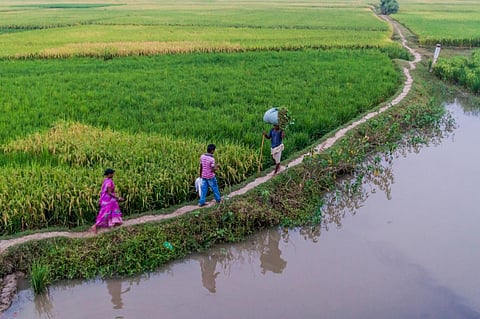Why Bihar needs climate-smart agricultural practices
Bihar, located in the country’s most fertile northern plains, is blessed with some of the finest fertile alluvial soils deposited by the mighty river Ganga and its tributaries. This makes it a state with huge potential and can make India a food-secure nation.
The eastern state’s weather also supports a diverse variety of crops. And maybe this is the reason why agriculture has become Bihar’s economic backbone for the past several decades. The sector engages 77 per cent of the state’s workforce and contributes to around 24.8 per cent of the state domestic product (SDP).
But this dependence of SDP on agriculture is highly susceptible to natural disasters (mainly hydro-meteorological) that adversely impact crop production, making economic development unpredictable.
The adverse effect results in huge crop loss every year. In the early months of 2021, the state encountered extreme weather events. Thousands of farms of West Champaran, East Champaran, and Muzaffarpur districts suffered unexpected flooding from river Gandak, which submerged a vast area of cultivated land (mainly paddy, sugarcane, and vegetable) soon after the onset of monsoon.
Almost 20 districts in the state were affected and around 400,000 hectares of kharif crops were damaged by the floods, the Government of Bihar estimated.
Around 3 million hectares out of the total 9.36 million hectares of cultivable land in Bihar fall under various flood hazard categories. Of this, 2.52 lakh hectares is in the ‘very high risk of flood’ category and 347,000 hectares in the category of ‘moderate flood’ hazard.
Muzaffarpur, Darbhanga, Khagaria and Katihar districts are the worst-hit by crop loss as they have a maximum cropped area under the category of ‘very high’ to ‘high’ risk of flood hazard.
In the last two decades, the cropped area affected by flood ranged from 0.01 million hectares to 1.40 million hectares. Climate change will have a significant impact on crop yields (major food crops) in 2020, 2050 and 2080, aggravating the condition, according to the prediction of the Indian Council of Agricultural Research (ICAR) under the National Network Project on Climate Change.
Bihar is highly vulnerable to hydro-meteorological natural disasters as it has both flood-prone and drought-prone areas. The northern part of Bihar is flood-prone as it lies in the ‘courtyard of Himalayan rivers’. Southern Bihar, on the other hand, is highly drought-prone as the area is in the ‘backyard of rivers’ that flow from the south. This combination leads the state to be in high disaster risk.
Fifteen districts — Darbhanga, Khagaria, Sitamarhi, Katihar, Muzaffarpur, Patna, Bhagalpur, Samastipur, East Champaran, Madhubani, Nalanda, Saharsa, Madhepura, Purnia and Sheohar — are worst-hit by floods, according to the flood hazard atlas on satellite data from 1998- 2019 by the National Remote Sensing Centre, the Indian Space Research Organisation, the National Disaster Management Authority in New Delhi and the Government of Bihar.
Bihar is, thus, one of India’s most flood-affected states. From 1998-2019, the state witnessed 10 high-magnitude floods (1998, 2004, 2007, 2008, 2012, 2013, 2016, 2017, 2018 and 2019) resulting in severe loss in the overall economy and development.
Similarly, around 19-21 districts face agricultural drought every year, of which five districts fall in the category of the severe drought-affected areas, according to a 2021 ICAR report. Vulnerability to hydro-meteorological natural disasters led to tragic conditions. In 2019, for instance, the state suffered from drought and flood simultaneously.
These hydro-meteorological natural disasters are becoming a hurdle for Bihar, as well as for India, in achieving the United Nations-mandated Sustainable Development Goals (SDG). The direct impact of this includes crop loss, unemployment and infrastructural losses. The hidden losses are malnutrition, illiteracy, poverty, among others.
The disasters continuously increase the number of people at risk of hunger, leading them into a vicious cycle of migration and displacement. Major economic loss due to damage to cropped land has been as high as Rs 366.96 crore (1998), Rs 768.38 crore (2007), Rs 685.87 crore (2017) and Rs 446.64 (2019).
The crisis shook the state’s economy, adding enormity to the challenge of food insecurity (SDG 2 — Zero Hunger), unemployment (SDG 8 — Decent Work and Economic Growth) and poverty (SDG 1 — No Poverty).
The United Nation agencies have recognised that any disaster adds enormity to a country in achieving SDG goals. In 2015, the United Nations International Strategy for Disaster Reduction Secretariat made it clear that for achieving SDGs, it is very important to reduce disaster-related risks.
Thus, Bihar needs to address Disaster Risk Reduction Targets 1.5, 2.4, 3.d, 4.7, 6.6, 9.1, 11.1 to 11.5, 13.1, 13.2, 13.3 (along with 13.a and 13.b), 14.2, 15.1 to 15.4 and 15.9 of SDGs through a promising agriculture system that will suit this new world of climate change.
Climate-smart agriculture (CSA) can be a possible way forward. In this, one opts for an approach where planning and investment in agriculture are done with due consideration of climate change and extreme weather event risks.
Crop production, livestock and aquaculture management as well as agroforestry are integrated in this approach. This leads to the improvement of water, pests and nutrient management. The practice also has a landscape approach that improves forestry and grassland management, providing alternate livelihood and food.
CSA, thus, lowers risks by increasing resilience for food security, employment as well as overall economic growth and development. It manages and reduces hydro-meteorological natural disasters risk, making Bihar more resilient to drought and flood by supporting equitable and sustainable development for the state.
The state should formulate an action plan for better implementation of CSA across the state, considering the crop loss due to hydro-meteorological disasters. Some districts are already under the Sustainable Livelihoods and Adaptation to Climate Change (SLACC) scheme initiated by the Union Ministry of Rural Development. The ministry covers the agriculture sector of drought and flood-prone areas.
The needs SLACC scheme for all 38 districts, considering their own risk of natural disasters and ways of mitigation.
Views expressed are the author’s own and don’t necessarily reflect those of Down To Earth.

